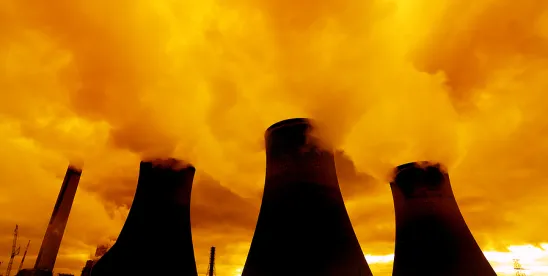The Trump administration has identified growth in the nuclear energy industry as a critical component of the President’s campaign to establish American energy dominance and meet the rapidly increasing need for power. The consistent backing of the White House, coupled with record-breaking investment in nuclear technology from the private sector, has vaulted enthusiasm for nuclear power in recent months. In response to calls for reform, President Trump recently issued four executive orders (EO) designed to bolster domestic nuclear energy development and supply chains and accelerate regulatory timelines for nuclear technology licensing.
Nuclear Energy Overview
Over the last 50 years, growth in US nuclear energy generation has been stagnant and slow. From 1954 to 1978, 133 nuclear reactors were authorized to operate at 81 facilities across the country. Since 2012, over a dozen reactors have been closed. Yet, efforts are now underway to restart some of these reactors. Plus, the Nuclear Regulatory Commission (NRC) has approved three new reactor designs, two of which have been advanced reactors using new technologies. Two nuclear reactors have also recently been constructed and placed into commercial operation, suggesting the long-awaited nuclear comeback may be at hand.
In recent years, support for nuclear energy has gained newfound momentum in the federal government and from private investment. Congressional efforts, including legislation like the Nuclear Energy Innovation and Modernization Act (NEIMA), the Accelerating Deployment of Versatile, Advanced Nuclear for Clean Energy (ADVANCE) Act, and the Inflation Reduction Act (IRA), have sought to energize nuclear development through regulatory reform, support for advanced reactor technologies, and federal tax incentives. These nuclear bills passed Congress with overwhelmingly bipartisan support and strong support from the nuclear industry.
Until the election of President Trump, nuclear advocates in Washington, D.C., had largely organized support for commercial nuclear around the unique benefits of providing clean baseload power and carbon-free energy. Now, support for nuclear is increasingly being reframed around the Trump administration’s commitment to establishing American energy dominance and capturing the promise of commercial nuclear technological innovation. In addition, the onset of artificial intelligence (AI) technology and the enormous projected power demands required to operate data centers and quantum computing capacity across the country have made nuclear energy a critical component of US energy planning. The Trump administration has identified winning the global race for AI capabilities as perhaps the most important national security concern, and competition in AI will require an unprecedented expansion of energy generation. After a decade of flat energy consumption rates, demand for power is expected to skyrocket in the coming years, up 25% by 2030 and 78% by 2050.1
Executive Order Summaries
The President’s nuclear EOs are focused on transforming the government’s role in how nuclear power plants are regulated, permitted, financed, and built—all with an eye towards rapidly and dramatically reversing the trends of minimal nuclear growth—and even some plant shutdown—to an explosion of new production, new reactors, license extensions, and uprates of existing facilities. To that end, the orders promise to ”facilitate the expansion of American nuclear energy capacity from approximately 100 GW in 2024 to 400 GW by 2050.” This target would require a four-fold increase in nuclear capacity in the next 25 years and would reverse a four-decade trend of minimal nuclear capacity growth.2
The EOs focus on several challenges, including time- and cost-prohibitive licensing and permitting, insufficient federal financing support and nuclear fuel supply, nuclear waste management, and domestic nuclear workforce issues. They also address government utilization of nuclear power on military and federal installations. The EOs address both the projected role of nuclear technology in US energy generation as well as US nuclear arsenal capabilities.
Reinvigorating the Nuclear Industrial Base
The “Reinvigorating the Nuclear Industrial Base“ EO states that US nuclear capacity has declined compared to the rest of the world and targets key areas of the nuclear industry to “jumpstart,” including fuel availability and production, secure supply chains, licensing efficiency, and workforce support.
Strengthening the Domestic Nuclear Fuel Cycle
- Directs the Secretary of Energy to prepare and submit within 240 days a report that audits previous nuclear procedures with respect to spent fuel and provides recommendations for transport, disposal, and reprocessing of spent nuclear fuel.
- Directs the Secretary to develop a plan within 120 days to expand the domestic uranium conversion capacity and enrichment capabilities sufficient to meet projected civilian and defense reactor needs and to halt the surplus plutonium “dilute and dispose” program and establish a program to dispose of surplus plutonium by processing and making it available for industrial use.
- Directs the Secretary within 90 days to update the Department of Energy’s (DOE) excess uranium management policy to modernize the US nuclear weapons stockpile.
- Directs the Secretary within 30 days to seek voluntary agreements with domestic nuclear energy companies.
Funding for Restart, Completion, Uprate, or Construction of Nuclear Power
- The Secretary, through the DOE Loan Programs Office, shall prioritize funding for activities that support nuclear energy.
- The Secretary shall also coordinate with the Secretary of Defense to assess the feasibility of restarting or repurposing closed nuclear power plants for military microgrid support.
Expanding the Nuclear Energy Workforce
- Directs the Secretary of Labor and the Secretary of Education within 120 days to seek to increase participation in nuclear energy-related apprenticeships and career and technical education programs and consider these areas as primary areas for investment when distributing educational grants.
Reforming Nuclear Reactor Testing at the Department of Energy
The “Reforming Nuclear Reactor Testing at the Department of Energy“ EO directs DOE to utilize existing national laboratories to test advanced reactor technology, concluding that the testing of advanced reactors over which DOE has “sufficient control” are for research purposes and thus fall within DOE’s research and development jurisdiction.
Reform National Laboratory Process for Reactor Testing
- Directs the Secretary of Energy to establish procedures that significantly expedite review, approval, and deployment of advanced reactors to enable operational test reactors within two years after a completed application.
Nuclear Reactor Pilot Program
- Directs the Secretary of Energy to create a pilot program to construct and operate at least three advanced reactors outside the National Labs, but under DOE contract. The goal is to achieve criticality for these advanced reactors by 4 July 2026.
Streamlined Environmental Review
- Directs the Secretary of Energy in conjunction with the Council on Environmental Quality Chair to reform DOE’s National Environmental Policy Act (NEPA) regulations and use all available authority to expedite environmental reviews for advanced reactor applications.
- Such measures shall include identifying DOE functions not subject to NEPA requirements and creating categorical exclusions for reactors, when appropriate.
- The EO does not address NRC NEPA-related regulatory reform.
Ordering the Reform of the Nuclear Regulatory Commission
The “Ordering the Reform of the Nuclear Regulatory Commission“ EO responds to criticism that NRC has received from the public, nuclear developers, and Congress for long licensing timelines and expensive, seemingly inefficient reviews. The EO specifically calls for facilitating increased development of Gen III and Gen IV reactors, small modular reactors (SMR), and microreactors, and sets an energy capacity target for nuclear generation of 400 GW by 2050, an ambitious four-fold increase.
The EO seeks to address identified obstacles to the development of commercial nuclear power at NRC in three ways:
Reform NRC’s Culture
- Directs NRC to implement the 2024 ADVANCE Act objective to promote nuclear power by reforming NRC’s culture and realigning its organization and personnel to achieve expeditious review of license applications.
Reform NRC’s Structure
- Directs NRC, in coordination with the assigned Department of Government Efficiency (DOGE) Team, to reorganize NRC’s organizational structure to promote “expeditious processing of license applications and the adoption of innovative technology.” This reorganization shall include reductions in force, including a reduction of personnel at the Advisory Committee on Reactor Safeguards (ACRS) to the minimum level required by statute, but includes a provision that permits increases in personnel and size for functions related to new reactor licensing.
Modernize NRC Regulation
- Directs NRC, in conjunction with DOGE and the Office of Management and Budget, to review all regulations and guidance documents within nine months and, within 18 months, issue final rules and guidance that comprehensively revise them to balance safety concerns with the benefits of nuclear energy to the economy and national security. The revisions will establish fixed deadlines for licensing, including an 18-month deadline for construction and operation of new reactors and a 12-month deadline for continued operation of existing reactors. These deadlines are to be enforced by a fixed cap on NRC recovery fees.
- Directs NRC to adopt “science-based radiation limits.” This includes reconsidering the linear no-threshold model for radiation exposure and the “as low as reasonably achievable” standard.
- Directs NRC to coordinate with DOGE, Department of Defense (DOD), DOE, Environmental Protection Agency, and others to develop and adopt “appropriate” radiation standards.
- Directs NRC to establish expedited licensing pathways for reactor designs that have been safety tested by DOD or DOE.
- Directs NRC to establish a process for licensing large numbers of microreactors and modular reactors, including the use of standardized applications.
- Directs NRC to revise and reconsider current NRC policies and regulations pertaining to changes to reactor design, reactor oversight, license terms, reactor license renewal, and the public hearing process.
Deploying Advanced Reactor Technologies for National Security
The “Deploying Advanced Reactor Technologies for National Security“ EO identifies advanced nuclear reactor technology as critical infrastructure to US national security. Specifically, the EO states that advanced reactors offer a high-density power source for military installations and National Laboratories that cannot be “disrupted by external threats or grid failures.”
Deployment of Advanced Reactor Technology on Military Installations
- Directs the Secretary of the Army to establish a program to build a nuclear reactor at a domestic military base and commence operation by 30 September 2028.
- Seeks recommendations for legislative proposals or regulatory actions necessary to accomplish this goal within 240 days of the EO.
Deployment of Advanced Reactor Technology at DOE Facilities
- Directs the Secretary of Energy to designate AI data centers operated on or in coordination with DOE facilities as critical defense facilities and further identify the electrical infrastructure—including nuclear infrastructure—necessary to power those defense facilities as critical electric infrastructure.
- The Secretary shall designate at least one DOE AI data center for the use and deployment of advanced reactor technology within 90 days of the EO.
- The Secretary shall utilize all available legal authorities to approve the construction and operation of privately funded advanced reactors to power AI infrastructure on DOE owned or controlled sites.
Nuclear Fuel Availability
- Requires the Secretary of Energy to identify all uranium and plutonium in DOE inventories that can be processed into fuel for reactors and release at least 20 metric tons of high assay low-enriched uranium (HALEU) in an available fuel bank for approved private sector projects. The Secretary is directed to retain stockpiles necessary to support tritium production, naval propulsion, and nuclear weapons.
- Directs the Secretaries of Defense and Energy to develop privately funded nuclear fuel recycling, reprocessing, and fabrication facilities on controlled sites.
Nuclear Exports
- Directs the Secretary of State to actively pursue at least 20 new Agreements for Peaceful Cooperation under Sec. 123 of the Atomic Energy Act to enable the US nuclear industry to access new markets.
- Directs all relevant agencies to expeditiously review and facilitate authorization to export nuclear technology to facilitate US technological leadership.
- Directs the development of a strategy to leverage the International Development Finance Corporation and the Export-Import Bank to provide financial support for US nuclear energy technology.
Looking Ahead: Impacts of Changes in Nuclear Policy
The EOs represent a significant shift from decades of federal positioning towards nuclear energy and the development of nuclear technology. Notably, President Trump appears to be addressing the perceived obstacles to nuclear expansion by creating new opportunities for DOE and DOD to take the lead on developing and demonstrating SMRs and other advanced nuclear reactors within their operations and under their jurisdiction, elevating the role of those agencies and perhaps diminishing the role of NRC with regard to a new reactor’s testing, planning, and maybe even its licensing and regulation. The EOs prioritize the development and deployment of public “test” and “government service” nuclear reactors under the authority of DOE and DOD rather than strictly commercial or private sector reactors under the authority of NRC. For example, the EOs require NRC to conduct a “wholesale revision” of its rules and guidance, including establishing “an expedited pathway to approve reactor designs that the DOD or the DOE have tested and that have demonstrated the ability to function safely,” and NRC’s review of such designs “shall focus solely on risks that may arise from new applications permitted by NRC licensure, rather than revisiting risks that have already been addressed in the DOE or DOD processes.”3
An effort to streamline and standardize aspects of new reactor licensing is a challenge based on the breadth of technologies involved. There is such a diversity of proposed new designs in the SMR and microreactor category that the NRC may struggle to meet this directive, at least with respect to certain types of reactors and with anticipated reductions in workforce.
The EOs’ effort to address the issue of spent fuel is laudable; however, the political implications of executing on such a plan have proved extremely difficult with no real progress on storage and disposal solutions having been made since the suspension of the Yucca Mountain project.
As NRC, DOE, DOD, and the nuclear energy industry respond to the EOs, several questions and developments will be critical to continue monitoring:
- Are DOE and DOD now the lead agencies for reactor technology demonstration?
- What does the future of the NRC look like, and how will these orders affect NRC leadership, organizational structure, responsibilities, and funding?
- How will the wholesale review of NRC regulations impact permitting, environmental review, application costs and timelines, and nuclear safety?
- Can NRC meet the aggressive deadlines set in the EOs, especially given the anticipated workforce needs?
- What will the regulatory and legislative responses to these orders be—and how will NRC and others meet their new requirements?
- Can DOE meet the aggressive deadlines for strengthening the domestic nuclear fuel and related nuclear infrastructure needs?
- How much capital support and investment will the financing opportunities included in the EOs provide?
- How will the EOs affect the nuclear power industry, such as interaction between established nuclear companies, start-ups with new technologies, utilities, and large consumers (such as hyperscalers)?
- How will the EOs affect nuclear development overseas and nuclear exports?
As these EOs are implemented and the nuclear industry reacts, the firm will continue to actively monitor these developments. Our legal, regulatory, and policy professionals have considerable experience across the spectrum of nuclear issues and are eager to help you navigate these evolving and fast-paced changes.
1 Lalit Batra, Deb Harris, George Katsigiannakis, Justin Mackovyak, Himali Parmar & Maria Scheller, Rising current: America’s growing electricity demand, ICF International, Inc. (Apr. 2025),
2 US Energy Information Administration, https://www.eia.gov/energyexplained/nuclear/us-nuclear-industry.php (last visited Jun. 4, 2024).
3 “Ordering the Reform of the Nuclear Regulatory Commission,” Executive Order Issued by President Donald J. Trump, May 23, 2025.
Katie E. Spring contributed to this article









 />i
/>i

